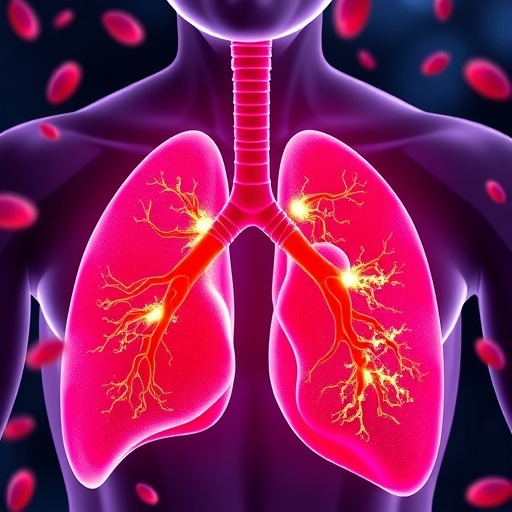Immunosuppressive therapy has emerged as a pivotal approach in managing pulmonary arterial hypertension (PAH), particularly in patients afflicted with connective tissue diseases (CTDs). The recent findings from a Japan-based registry have illuminated the potential therapeutic benefits of immunosuppression in a demographic where conventional treatment options are limited. This comprehensive exploration highlights the intersection between CTDs and pulmonary hypertension, a condition characterized by elevated blood pressure in the pulmonary arteries, which, when intertwined, poses significant challenges for patient management.
Pulmonary arterial hypertension is a complex cardiovascular disorder that can result from various underlying causes, including chronic lung diseases, congenital heart defects, and, notably, connective tissue disorders such as systemic sclerosis and systemic lupus erythematosus. These rheumatological diseases not only lead to increased morbidity and mortality in patients due to their systemic effects but also exacerbate the severity and progression of pulmonary hypertension. Therefore, understanding the mechanisms linking CTDs to PAH is crucial for developing effective therapeutic strategies.
The Japanese registry highlighted in this investigation provides a unique perspective on immunosuppressive therapy’s role in treating pulmonary arterial hypertension associated with connective tissue diseases. The study meticulously analyzed data from a diverse cohort of patients suffering from both conditions, offering insights into treatment responses, outcomes, and adverse events associated with immunosuppression. Preliminary results suggest that patients receiving immunosuppressive therapy exhibited improved hemodynamic parameters, as well as enhanced exercise capacity, depicting a nuanced approach to managing a notoriously challenging condition.
The rationale behind utilizing immunosuppressive therapy in this patient population is rooted in the inflammatory processes that characterize CTDs. Autoimmune diseases often lead to endothelial dysfunction, vascular remodeling, and increased vascular resistance, all of which contribute to the development of PAH. By employing immunosuppressive agents, clinicians aim to mitigate these inflammatory responses, potentially slowing disease progression and improving overall clinical outcomes. Thus, the therapeutic landscape for this dual pathology is increasingly geared toward exploring optimal immunosuppressive regimens.
The registry’s methodology involved a detailed retrospective analysis, allowing researchers to draw correlations between various treatment modalities and patient outcomes. Of particular interest were the comparative effects of traditional PAH therapies, such as endothelin receptor antagonists, phosphodiesterase-5 inhibitors, and prostacyclin analogs, in conjunction with immunosuppressive agents like corticosteroids, mycophenolate mofetil, and cyclophosphamide. The study underscored the importance of personalized medicine, tailoring immunosuppressive strategies based on individual patient profiles and disease severities.
Safety is a paramount concern when considering immunosuppressive therapies, particularly given the fragile health status of patients with CTDs and PAH. The registry reported a thorough assessment of adverse events linked to both immunotherapy and traditional pulmonary hypertension treatments. Importantly, it was noted that while some patients experienced mild to moderate side effects, the majority tolerated immunosuppressive therapy without significant complications. This favorable safety profile is promising and encourages further research into this therapeutic avenue.
Moreover, the findings underscore the necessity for multidisciplinary approaches in managing patients with pulmonary arterial hypertension related to connective tissue diseases. The integration of rheumatologists, pulmonologists, and cardiologists is essential to ensure comprehensive care. This collaborative model not only fosters improved clinical outcomes but also allows for more nuanced discussions surrounding treatment goals and patient expectations.
The implications of this research extend beyond immediate clinical practice; they beckon a paradigm shift in the understanding of how we approach pulmonary arterial hypertension in the context of connective tissue diseases. The evidence presented in the registry underscores the need for larger, controlled trials to firmly establish the benefits of immunosuppressive therapy in this unique patient population. Such studies could provide the foundational data necessary to influence clinical guidelines and reshape management strategies worldwide.
Furthermore, the findings pose significant questions about the long-term effects of immunosuppressive therapy on pulmonary vascular remodeling and inflammation. While improvements in hemodynamics and symptoms are critical, understanding the durability of these effects remains crucial. Equally important is the need to investigate whether early intervention with immunosuppressive therapy can prevent the progression of pulmonary hypertension in patients with CTDs, thereby altering the disease trajectory.
In conclusion, the burgeoning research on immunosuppressive therapy for pulmonary arterial hypertension associated with connective tissue diseases represents a compelling frontier in medical science. The insights gained from the Japanese registry not only underscore the potential for improved patient outcomes but also highlight an area ripe for future exploration. As the medical community grapples with the complexities of autoimmune disorders and their systemic manifestations, this line of inquiry heralds promise for a more sophisticated, effective approach to one of the most challenging aspects of contemporary medicine.
Ultimately, the ongoing dialogue among researchers, clinicians, and policymakers will be essential in harnessing these findings into actionable treatment pathways. By prioritizing research that bridges the gap between immunology and cardiopulmonary health, the medical community can pave the way for innovative therapies that will elevate the standard of care for patients facing the dual burden of pulmonary arterial hypertension and connective tissue diseases.
Subject of Research: Immunosuppressive therapy for pulmonary arterial hypertension associated with connective tissue diseases.
Article Title: Immunosuppressive Therapy for Pulmonary Arterial Hypertension Associated with Connective Tissue Diseases: Insights from Japanese Registry.
Article References:
Tamura, Y., Tamura, Y., Takemura, R. et al. Immunosuppressive Therapy for Pulmonary Arterial Hypertension Associated with Connective Tissue Diseases: Insights from Japanese Registry. Adv Ther (2025). https://doi.org/10.1007/s12325-025-03389-z
Image Credits: AI Generated
DOI: 10.1007/s12325-025-03389-z
Keywords: Pulmonary arterial hypertension, connective tissue diseases, immunosuppressive therapy, Japanese registry, systemic sclerosis, systemic lupus erythematosus, personalized medicine, cardiovascular disorders.
Tags: challenges in treating pulmonary arterial hypertensionconnective tissue diseases and PAHeffects of systemic sclerosis on pulmonary arterial hypertensionimmunosuppressive therapy for pulmonary hypertensionJapanese registry on PAH treatmentmanagement of pulmonary hypertension in CTDsmorbidity and mortality in connective tissue diseasespatient management in pulmonary hypertensionrheumatological diseases and cardiovascular healththerapeutic approaches for connective tissue disorderstreatment strategies for pulmonary arterial hypertensionunderstanding mechanisms linking CTDs and PAH





